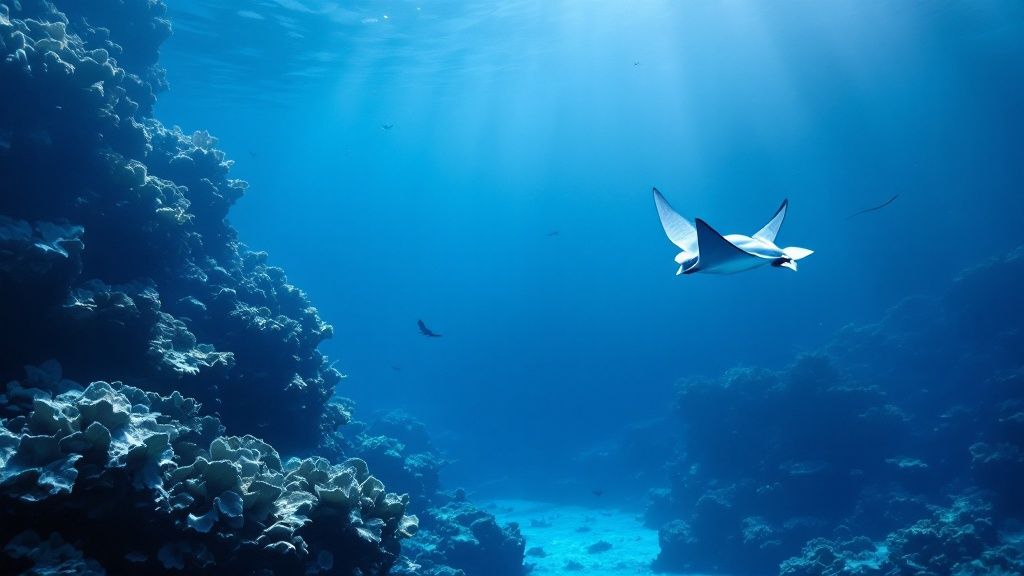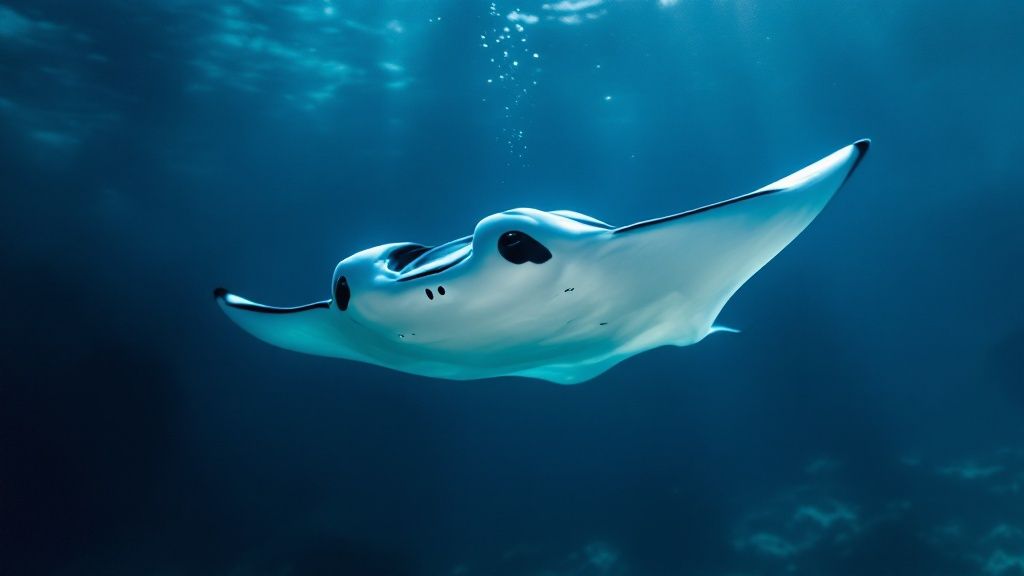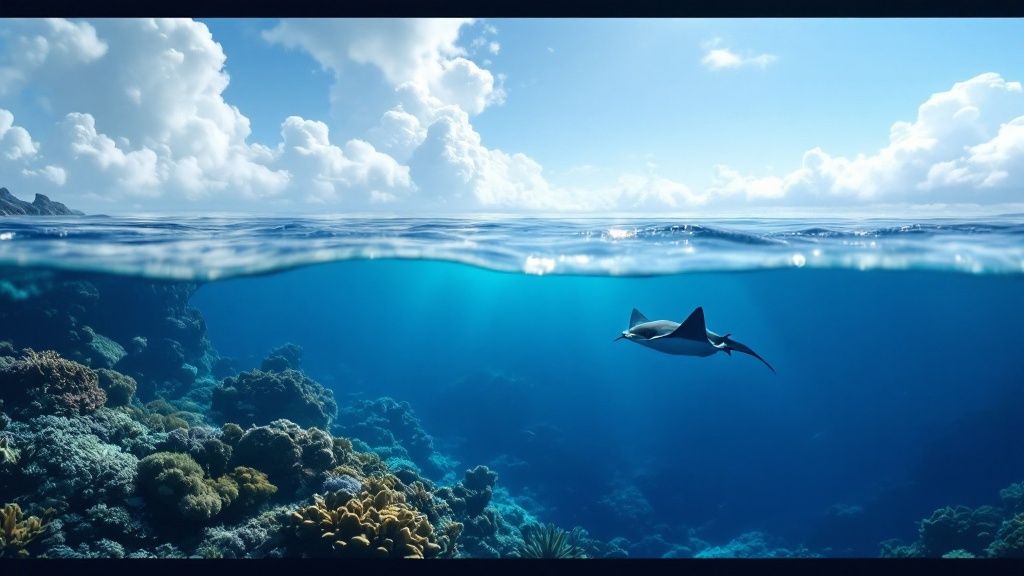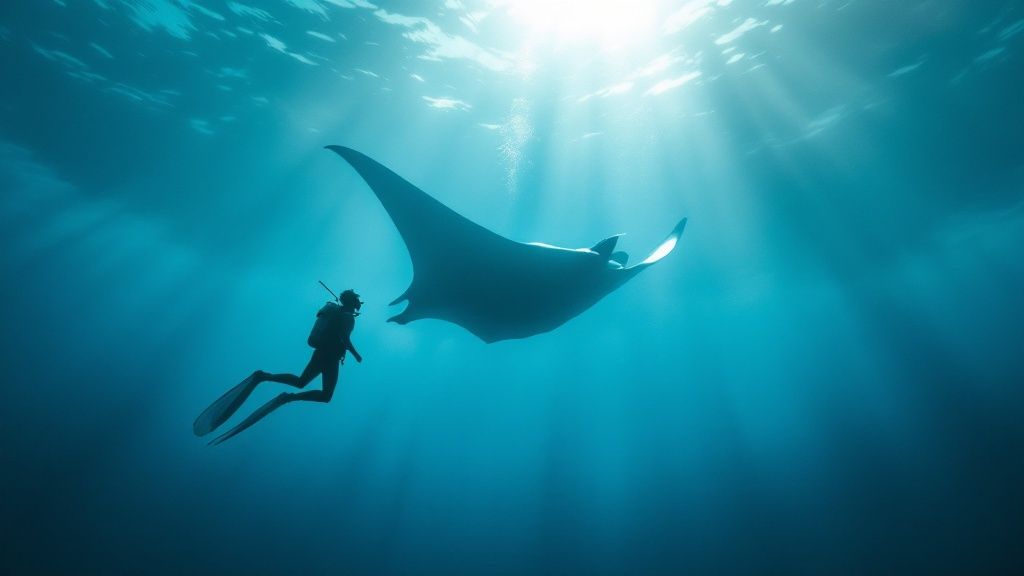The Magic Behind Hawaii's Legendary Manta Encounters
Hawaii's volcanic origins have shaped a unique underwater world, crucial to the thriving manta ray population. Volcanic slopes, plunging into the deep ocean, create ideal conditions for upwelling. This process brings nutrient-rich waters to the surface, fueling the growth of microscopic plankton, the manta ray's main food source. This constant food supply allows these gentle giants to flourish year-round.
The Kona Coast: A Manta Ray Hotspot
The Kona Coast is famous for its reliable manta ray sightings. This is thanks to several factors, including the volcanic activity and ocean currents that carry plankton into the area. This predictable food source creates a nightly feast for the manta rays, drawing them to specific spots along the coast. These locations, often lit by dive lights to concentrate plankton, offer amazing viewing opportunities for divers and snorkelers. Areas like Manta Village and Manta Heaven have become closely associated with these magical encounters. The Kona Coast has consistently recorded manta ray sightings, with data from 2009 to 2014 showing clear patterns. Detailed records from this period have deepened our understanding of manta ray behavior. More detailed statistics can be found here: Manta Ray Statistics
The Role of Plankton and Ocean Currents
Plankton abundance isn't solely due to volcanic activity. Hawaii's location in the Pacific Ocean also plays a significant role. The warm, nutrient-rich currents circulating around the islands create perfect conditions for plankton blooms. These blooms, often invisible, are the foundation of the marine food web, supporting not only manta rays but a wide array of marine life. This interconnectedness highlights the importance of a healthy ocean.
Cultural Significance of Manta Rays
Beyond their ecological importance, manta rays hold cultural significance in Hawaiian tradition. These majestic animals are often seen as symbols of grace, wisdom, and good fortune. Historically, they were revered as spiritual guardians, adding a deeper meaning to encountering them in their natural habitat. This respect for nature is woven into Hawaiian culture and underscores the importance of responsible tourism.

Hawaii's Premier Manta Ray Diving Locations Revealed
Hawaii's breathtaking underwater world offers incredible opportunities for manta ray diving. From volcanic slopes to vibrant coral reefs, the islands provide diverse habitats where these graceful giants flourish. But where are the absolute best spots to experience these magnificent creatures in Hawaii?
Kona Coast Dive Sites: A Trio of Manta Magic
The Kona Coast on the Big Island is famous for its consistent manta ray sightings. Three primary locations in this area consistently attract these gentle giants: Keauhou Bay, the waters near Kona International Airport (Keahole), and the area between Kawaihae Harbor and the Kohala Resorts. These sites have become prime destinations for divers and snorkelers alike, eager for close encounters with manta rays. Keauhou Bay, for example, home to the well-known "Manta Village," is renowned for its high concentration of manta rays and excellent visibility.
Manta ray diving is incredibly popular in Hawaii, particularly on the Big Island, where night dives are standard practice for observing these creatures feeding beneath artificial lights. This type of diving, known as 'bonfire' or 'campfire' diving, attracts swarms of plankton, which in turn brings in the manta rays. Popular sites include 'Manta Village' in Keauhou Bay and 'Manta Heaven' in Ho'ona Bay. These locations consistently draw large numbers of divers and snorkelers throughout the year, with no specific seasonal changes influencing manta ray presence. As of 2017, the three most frequented manta ray night dive sites on the Island of Hawaii are in front of the Sheraton Kona Resort & Spa at Keauhou Bay, near the Kona International Airport at Keahole, and between Kawaihae harbor and the Kohala resorts. Learn more here: Manta Ray Night Dive
Beyond the Famous: Discovering Hidden Gems
While the Kona Coast's famous locations provide dependable manta ray encounters, exploring lesser-known areas can lead to even more rewarding dives. This often involves venturing to spots favored by local dive masters, where you might find yourself interacting with manta rays in smaller, more private groups. These hidden gems provide a chance to escape the crowds and experience the true wonder of these creatures in a more natural setting.
Choosing the Right Site: Factors to Consider
Choosing the right manta ray diving location hinges on several factors. Your experience level is crucial. Some sites are more beginner-friendly, with shallower depths and calmer waters. Accessibility is another key aspect; some areas may require boat trips or extended swims from the shore. Finally, consider the kind of manta ray experience you're seeking. Some sites are known for larger gatherings of mantas, while others offer a more intimate encounter with individual rays.
To help you choose the perfect dive site, take a look at this comparison:
Hawaii's Premier Manta Ray Dive Sites Comparison: A comprehensive comparison of the top manta ray diving locations in Hawaii, highlighting their unique features, accessibility, and sighting rates.
| Dive Site | Location | Best For | Average Mantas | Depth | Experience Level | Accessibility |
|---|---|---|---|---|---|---|
| Manta Village (Keauhou Bay) | Kona Coast, Big Island | Beginners, night dives | High | 30-40ft | Beginner – Advanced | Boat, shore |
| Manta Heaven (Ho'ona Bay) | Kona Coast, Big Island | Night dives, photography | High | 30-40ft | Intermediate – Advanced | Boat |
| Kona International Airport (Keahole) | Kona Coast, Big Island | Experienced divers | Moderate | 40-50ft | Intermediate – Advanced | Boat |
| Kawaihae Harbor – Kohala Resorts | Kona Coast, Big Island | Experienced divers, larger groups | Moderate | 40-50ft | Intermediate – Advanced | Boat |
| Hidden Gems (vary) | Throughout the islands | Small groups, unique encounters | Varies | Varies | Varies | Boat, shore |
This table summarizes key characteristics of popular manta ray dive sites, helping divers choose the spot that best suits their needs and experience level. Remember to consult with local dive operators for the most up-to-date information.
Site-Specific Techniques for Optimal Encounters
Experienced dive masters often use location-specific strategies to improve the odds of exceptional manta ray interactions. These techniques can involve strategic positioning in the water, utilizing dive lights to attract plankton, and understanding the local currents and underwater terrain. This specialized knowledge enhances the dive, allowing for observation of manta rays' natural behaviors like feeding and interacting.

Ocean Conditions and Seasonal Recommendations
Visibility and ocean conditions can greatly influence your manta ray diving experience. These conditions fluctuate between locations and throughout the year. For instance, certain bays might have calmer waters during summer, offering better visibility. Experienced dive operators can provide valuable information on the ideal times to visit particular sites based on seasonal trends. Understanding how these factors affect visibility allows you to plan your dive strategically, improving your chances of a memorable manta ray encounter.
Day vs. Night: Two Distinct Manta Ray Experiences

Manta ray diving in Hawaii offers two dramatically different adventures: daytime and nighttime encounters. Each period reveals unique manta ray behaviors, making for captivating dives that cater to various preferences.
Daytime Encounters: Graceful Gliders in the Blue
During daylight hours, manta rays exhibit a range of behaviors. From leisurely cruising to cleaning sessions at specific reef stations, they glide effortlessly through the water. Often near the surface, they offer breathtaking views in the clear Hawaiian waters. This is an excellent opportunity to witness their natural movements and how they interact with the surrounding reef ecosystem. Daytime dives showcase their graceful ballet in a vibrant, sunlit world.
Nighttime Encounters: The Ballet of the Plankton Feeders
As darkness descends, a truly remarkable transformation occurs. Dive lights attract plankton, the manta ray's main food source, setting the stage for a captivating spectacle. The manta rays perform an enchanting underwater dance, circling and swooping through the illuminated water as they feast. This "bonfire diving" experience creates a surreal atmosphere, allowing you to observe these gentle giants up close during their feeding frenzy.
Consider this: manta rays are seen over 80% of the time during night dives at Kona's 'Manta Ray Heaven' and 'Garden Eel Cove'. Divers typically encounter five to six manta rays per dive, on average. Some incredible nights have even recorded as many as 36 manta rays! Want to learn more? Check out this article: What is Best Time of Year To See Manta Rays In Kona?
Choosing Your Adventure: Which Dive is Right for You?
The choice between a day and night manta ray dive truly depends on your personal preferences and diving experience. Daytime dives are ideal for those who enjoy observing natural behaviors in a bright, open ocean environment. This option may also be more comfortable for less experienced divers, who might find nighttime conditions more challenging. However, night dives offer a unique and otherworldly opportunity to witness the mesmerizing manta ray feeding frenzy.
Preparing for Your Manta Ray Encounter: Gear and Mindset
Whether you choose a day or night dive, proper preparation is key. For night dives, certain equipment is essential. A high-quality dive light is crucial, and many dive operators provide specialized boards equipped with lights to attract plankton. Wetsuits are generally recommended for both day and night dives, as even tropical waters can become chilly after extended periods. Mental preparation is equally important. Understanding manta ray behavior and respecting their space is vital for a safe and enjoyable experience. For night dives, managing any apprehension about being in the open ocean at night is also essential for a positive experience.
A Summary of Day vs. Night Manta Ray Diving
To help you decide, let's summarize the key differences between these two incredible experiences in a handy comparison table:
Night vs. Day Manta Ray Diving: What to Expect
| Aspect | Night Diving | Day Diving | Best For |
|---|---|---|---|
| Visibility | Limited to the illuminated area | Natural light, broader visibility | Photographers seeking wide-angle shots |
| Behavior | Feeding frenzy, dynamic movements | Graceful gliding, cleaning stations | Observing natural behaviors |
| Experience | Surreal, otherworldly | Calm, tranquil | Beginners, anxiety-prone divers |
| Equipment | Dive light essential, wetsuit recommended | Wetsuit recommended | Photographers focused on manta rays |
By understanding these distinctions, you can make an informed choice and select the manta ray diving adventure in Hawaii that best fulfills your diving dreams.
Planning Your Dream Manta Ray Diving Adventure
Turning your manta ray diving dream into a reality begins with a solid plan. Hawaii offers incredible manta ray encounters, but a well-structured approach will ensure you get the most out of your trip. This means considering the ideal time to visit, understanding the necessary certifications, and picking the right dive operator.
Timing Your Trip for Optimal Manta Ray Sightings
Manta rays grace Hawaiian waters throughout the year, but specific periods offer better viewing opportunities. The dry season, typically from April to October, usually has calmer waters and better visibility. The summer months (June to August) are often the peak season for visibility. However, this also coincides with increased tourist activity, so booking your dive in advance is essential. This will help secure your spot, particularly if you plan on multiple dives or have specific time slots in mind.
Certification and Experience Levels
Manta ray diving caters to a range of experience levels. Some dive sites are perfect for beginners, offering shallow depths and calm conditions. Others might require advanced certifications due to depth or currents. Be sure to select a dive site that aligns with your skill level. Most reputable dive operators provide detailed information regarding required certifications for each dive site. If you're new to night diving, or being in the ocean at night, you can learn about what to expect from operators like Kona Honu Divers. Discussing your experience level with the dive operator will ensure a safe and enjoyable dive.
Selecting the Right Dive Operator
Choosing a reputable dive operator is critical for a successful manta ray diving adventure. Seek out operators dedicated to sustainable practices and manta ray conservation. Their expertise is invaluable, as they possess a deep understanding of manta ray behavior and the local environment. They can also provide helpful information about the best dive locations and times based on current conditions. Kona Honu Divers, for instance, specializes in these types of dives and is highly regarded for their services.

Essential Booking Strategies and Dive Preparation
Smart booking tactics can greatly enhance your manta ray diving experience. Booking early is key, but also consider scheduling your dive for the beginning of your trip. Many operators offer a "manta ray guarantee," allowing you to re-book free of charge if no manta rays are seen on your initial dive. This is a major advantage when dealing with wild animals, as their behavior is unpredictable. In terms of dive preparation, having the right gear is essential. A wetsuit is vital for both day and night dives to stay warm. For night dives, a quality dive light is a must, though many operators provide specialized boards with integrated lights for attracting plankton. For those interested in learning more about manta ray night encounters, Manta Ray Night Snorkel provides valuable insights.
Accommodation and Itinerary Planning
Choosing accommodations near your selected dive locations can save valuable time and create a more streamlined experience. Look for hotels or rentals near the harbor or with easy access to the best dive sites. Planning your overall Hawaii itinerary with backup dive opportunities is also recommended. This flexibility allows for alternative options should weather or other unexpected events disrupt your original dive plans.
Managing Expectations and Mental Preparation
Finally, mental preparation for your manta ray encounter is just as important as the logistical aspects. Remember that these are wild creatures and their behavior isn't guaranteed. Managing your expectations and embracing the unpredictable nature of these encounters will enhance the overall experience. Any concerns regarding night diving or being in the open ocean should be discussed with your chosen dive operator. They can provide reassurance and guidance for a positive and memorable experience.
Protecting Hawaii's Gentle Giants: Ethical Manta Tourism
Manta ray diving in Hawaii offers an incredible chance to witness these majestic creatures in their natural environment. However, the increasing popularity of this activity carries a responsibility to protect the very animals that draw tourists. Ethical manta tourism is essential for the long-term well-being of these gentle giants and the overall health of the Hawaiian marine ecosystem.
Understanding the Impact of Tourism
Manta rays contribute significantly to the local economy. For instance, night dive operations generate over $2.5 million annually for the Hawaiian community. This highlights the importance of sustainable tourism practices to protect both the manta rays and their delicate habitat. Learn more about the economic impact of manta rays here: Manta Ray Research & Conservation
Since 2009, protective laws in Hawaii have prohibited the capturing and killing of manta rays, contributing to a stable population. However, global issues like the demand for manta ray gill plates for certain medicinal practices threaten populations elsewhere. This underscores the importance of ongoing conservation efforts worldwide.
Recognizing Signs of Manta Ray Stress
Responsible manta ray diving requires understanding and respecting the animals’ natural behaviors. It's crucial to recognize subtle signs of stress in these creatures. These signs can include rapid wing flapping, erratic movements, and attempts to evade divers. Just like us, manta rays have individual comfort levels with human interaction.
Practicing Responsible Diving Techniques
Ethical diving practices directly benefit manta rays. Maintaining a safe distance and avoiding sudden movements are key to minimizing disturbances. Dive lights should be pointed upwards, mimicking the natural light source that attracts plankton, their primary food source. This avoids disorienting or overwhelming the manta rays.
Never attempt to touch a manta ray. Their skin is covered in a protective mucus layer essential for their immune system. Even seemingly harmless contact can disrupt this layer, increasing their susceptibility to disease.
Supporting Ethical Dive Operators
Choosing a responsible dive operator is fundamental to ethical manta tourism. Seek out operators who actively engage in conservation initiatives, like the Manta Ray Awareness Program, and prioritize sustainable practices. These operators often exceed basic regulations by implementing stricter guidelines for their dives and educating divers about respectful manta ray interactions. Don’t hesitate to ask potential operators about their conservation efforts and the specific steps they take to protect manta rays during dives.
Contributing to Conservation Efforts
Your dive can support ongoing research and conservation. Many operators collaborate with researchers, collecting valuable data through photo-identification of individual manta rays. This data helps track population trends, understand migration patterns, and identify individual animals. This "citizen science" approach allows tourists to actively participate in manta ray conservation, making a dive more than just a memorable experience.
Reducing Your Environmental Footprint
Minimizing your overall environmental impact in Hawaii goes beyond the manta ray encounter itself. Using reef-safe sunscreen prevents harmful chemicals from entering the ocean. Reducing single-use plastics and practicing proper waste disposal on land and at sea also makes a difference. These small actions add up to a healthier ocean, benefiting not just manta rays but the entire ecosystem. By embracing ethical and responsible practices, we can ensure future generations have the opportunity to experience these amazing encounters with manta rays.
Beyond The Surface: Stories From The Manta Ray World
Manta ray diving in Hawaii offers more than just an adrenaline rush; it's a chance to connect with these gentle giants on a profoundly personal level. To truly grasp the magic of these encounters, let's delve into the stories of those who have dedicated countless hours to observing these magnificent creatures: veteran dive guides, marine photographers, and dedicated researchers.
Unexpected Behaviors: Playful Curiosity and Recognition
Dive guides often recount incredible tales of manta rays exhibiting surprising behaviors. Some mantas, for example, seem to display a playful curiosity, interacting with divers’ bubbles. Others appear to recognize familiar faces returning to the waters, suggesting a level of intelligence and social awareness that leaves a lasting impression. These personal anecdotes add a rich layer to manta ray diving in Hawaii, transforming a simple observation into a sense of shared connection.
Cultivating Presence and Calm: Enhancing the Encounter
Experienced divers stress the importance of cultivating a calm and present state of mind underwater. This benefits both the diver and the manta rays. By remaining still and avoiding sudden movements, divers create a comfortable space for these gentle giants, fostering closer, more natural interactions. This mindful approach allows divers to fully absorb the grace and beauty of the mantas, creating a truly immersive experience. This means resisting the urge to pursue or touch the mantas, respecting their space and allowing them to dictate the flow of the encounter.
Addressing First-Time Diver Concerns: Managing Expectations
Many first-time manta ray divers experience a mixture of excitement and trepidation. It’s perfectly normal to feel some anxiety, particularly about night diving in the open ocean. However, experienced guides understand these concerns and provide reassurance and support. They emphasize the gentle nature of manta rays, highlighting their harmless filter-feeding habits. Managing expectations is also crucial. Wild animal encounters are inherently unpredictable; there are no guarantees of specific behaviors or interactions. Embracing this uncertainty enhances the experience, allowing divers to connect with nature on its own terms.
Transformative Encounters: A Changed Perspective
Perhaps the most powerful stories come from divers who describe manta ray encounters as life-changing experiences. These encounters often ignite a deeper appreciation for the ocean and its diverse inhabitants, leading to a more profound connection with the natural world. This shift in perspective can be incredibly impactful, inspiring many to become advocates for marine conservation and responsible tourism. It’s a testament to the captivating nature of manta ray diving in Hawaii, where the elegance and grace of these creatures touch the hearts of those who venture beneath the waves.
Ready to experience the magic of manta ray diving in Hawaii? Book your unforgettable adventure with Kona Honu Divers today! Book Your Manta Ray Dive Now!
